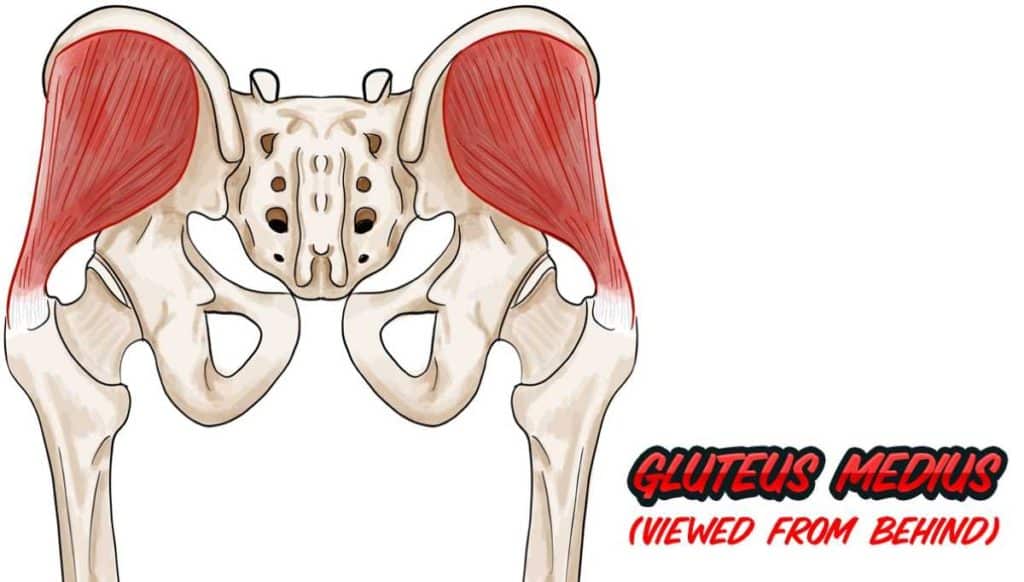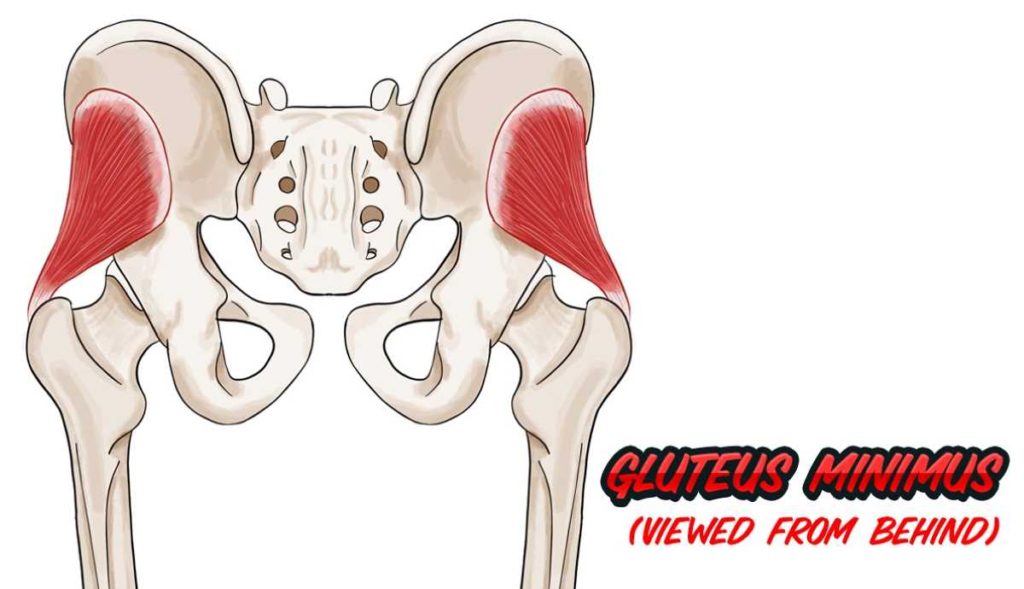Yes, you can walk sideways on a treadmill and yes, it has some pretty great benefits so long as you do it appropriately. If there’s one thing you need to know when it comes to exercise equipment, it’s that any piece of equipment can be used in a multitude of ways, be it conventional or unconventional. So long as it’s effective and you stay safe while doing so, it’s not “wrong”. What’s “wrong” is thinking you can only use exercise equipment the exact same way that everyone else does.
Walking sideways on a treadmill can be extremely beneficial for improving strength and mobility of the hips and legs while simultaneously improving lower body coordination. Doing so is also rather mentally engaging and is a great way to add variety into your treadmill exercise routine.
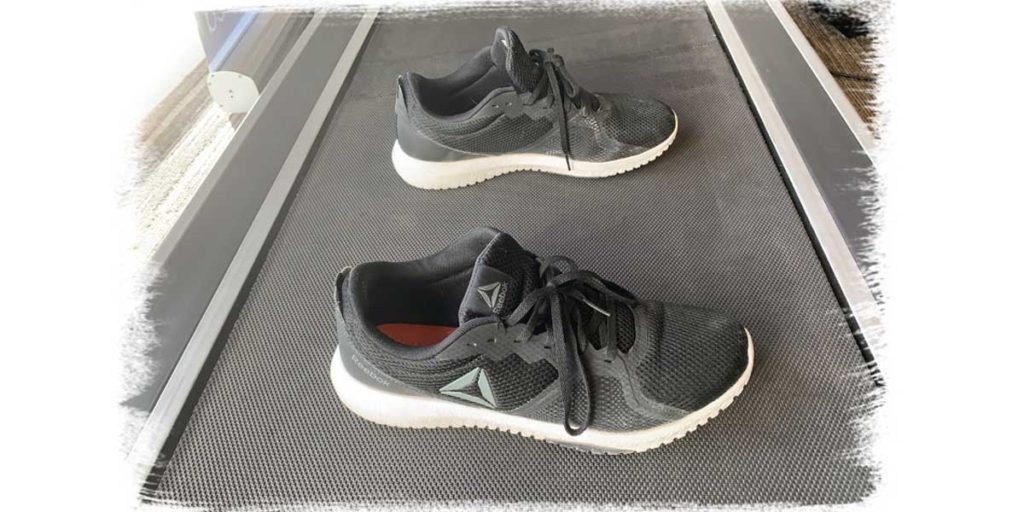
So, don’t think that there’s nothing beneficial about walking sideways on a treadmill simply because you’ve never seen anyone else do so. People don’t perform sideways walking on a treadmill not because it’s ineffective or treadmills can’t be used in such a manner, but rather because they simply don’t realize how beneficial doing so can be.
Get a bit versatile with exercise equipment and you can reap some massive rewards!
So, if you’re wanting to know the details behind these unique benefits and why you should consider incorporating some of this sideways movement into your training or exercise regimens, then be sure to keep on reading, as the remainder of this article will open your eyes to what you’ve likely been missing out on!
To help you save time, you can use the article headlines below to instantly navigate to that section of the article. These are quick links, so simply click (or tap) on the following article headlines to jump to that particular section.
ARTICLE OVERVIEW:
Benefit 1: Improved hip joint and groin mobility
Benefit 2: Improved coordination and balance for the lower body
Benefit 3: Improved hip and leg strength
Benefit 4: Improved training variety
Benefit 5: It’s mentally engaging & requires concentration
Bonus: Three different ways to walk sideways on a treadmill
Final thoughts
Benefit 1: Improved hip joint and groin mobility
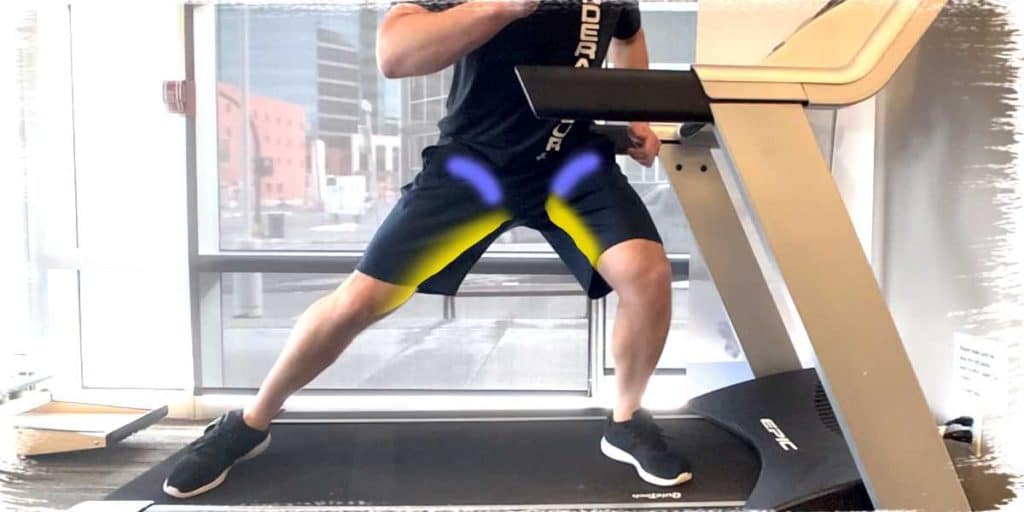
One of the most common deficiencies of the average gym-goer or home exercising individual is that their training is often heavily dominant if not exclusive to moving only in a forwards/backwards plane of motion. This plane of movement for the human body is known as the sagittal plane, and activities such as walking, jogging, squatting and lunging tend to take place exclusively in the sagittal movement plane.
While the aforementioned exercises are still incredibly beneficial and wise to incorporate, our bodies are designed to move in multiple directions or planes of movement, not just forwards and backwards. When we only move in a forwards and backwards plane without ever moving through other planes (i.e. in multiple directions), the mobility of our joints and muscles tend to break down much more quickly and easily. This leads to movement dysfunction and oftentimes pain as well.
Think about it for a second: how often throughout the week do you move sideways or diagonally for at least a few minutes on end? For the average joe, it’s hardly ever. And even if you do move in these directions a few times on a weekly basis (which is awesome, by the way), are they big, challenging movements or little, wimpy movements? Something is better than nothing here, of course, but you’d be wise to consider maximizing your sideways movement demands.
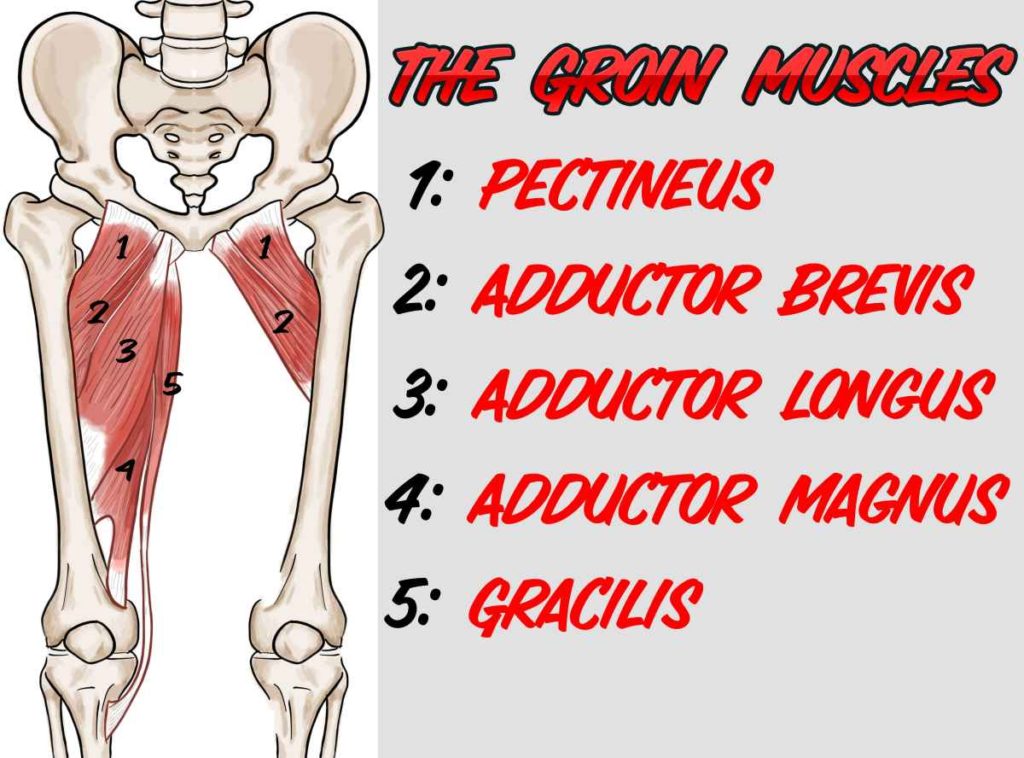
If your hip joint and/or inner thigh muscles are stiff and feel lousy from having been neglected in your training habits, walking sideways on a treadmill is an absolutely brilliant way to help restore specific motions of your hip joint and inner thigh muscles.
By stepping sideways, your hip joint (which is known as a ball and socket joint) has to produce a specific type of movement, known as abduction, which is a movement it doesn’t have to do when training exclusively with forwards & backwards (sagittal plane) exercises.
Not only does this sagittal motion help to keep the hip joint healthy (the more a joint is moved on a regular basis, the healthier it tends to stay), but the side-stepping motion on the treadmill also forces the groin muscles (a group of muscles on the inner thigh) to have to lengthen out in order to let the movement occur. Since the average individual performs little sideways movement on a regular basis, these muscles can become stiff and immobile since they never really have to stretch or lengthen out in order to let the movement occur.
So, by putting sideways movement (such as walking, in this case) into your training routine, you’re repeatedly telling these muscles that they need to lengthen out and relax in order for the side-stepping to occur.
Pro tip: When it comes to sideways walking on the treadmill, you can do smaller, shorter steps or larger, longer side-steps based on your own individual abilities or needs. The larger the side-step, the greater the groin muscles have to lengthen out (and the greater the stretch you’ll feel). Whichever type of sidestepping you perform, make sure it always feels comfortable and that you always feel that you’re in control when performing the movement(s).
Benefit 2: Improved coordination and balance for the lower body
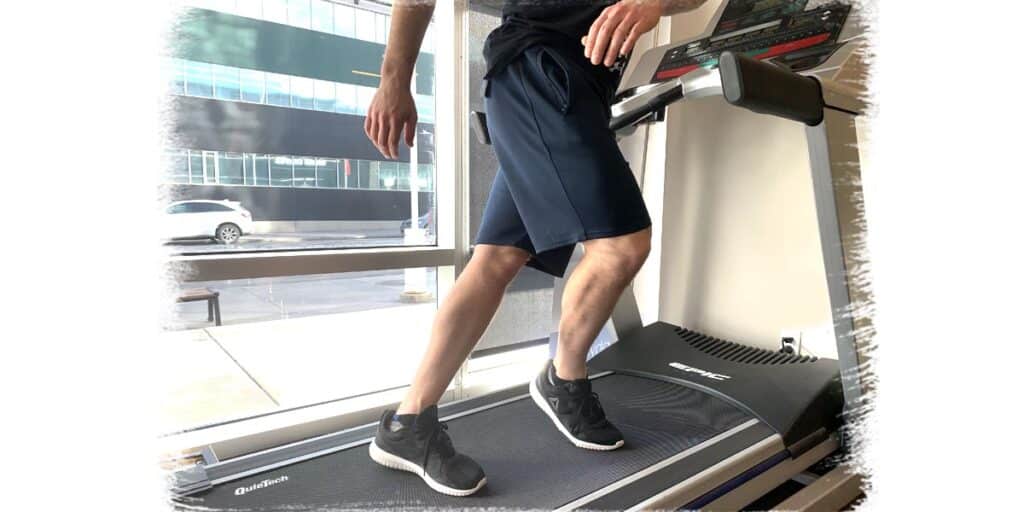
Walking sideways for repeated steps at a time isn’t the most naturally feeling movement for most individuals since it’s not a movement that we often perform and are thus much less experienced with. As a result, we tend to have lower amounts of coordination when moving our legs in this direction. Subsequently, we also tend to have less balance during these movements since we have a harder time achieving stability throughout the side-stepping process.
Needless to say, practicing walking sideways can be the perfect remedy for these issues. As our brain begins to improve our ability to effectively and reliably complete these challenges, our coordination and balance tend to improve. Improvements in both coordination and balance can help immensely with movement confidence and reduction in falls, which are both critical for safety and overall well-being of any individual.
Pro tip for coordination: If you’re not confident with your coordination, start with the side-shuffle pattern (read the bonus section at the end of this article for the different patterns you can try). If you’re semi-confident with your coordination, try the front leg or back leg crossover pattern. And if your confidence is really rockin’, try the alternating crossover pattern. Keep in mind: each pattern has great benefits and should be performed based on what you’re most comfortable with.
Pro tip for balance: If you aren’t confident in your coordination or want to make sure you feel completely safe and in control throughout the movement, start with very slow treadmill speeds and hold onto the treadmill rail in front of you. There’s nothing wrong with holding onto the rail until you feel 100% confident that you no longer need it.
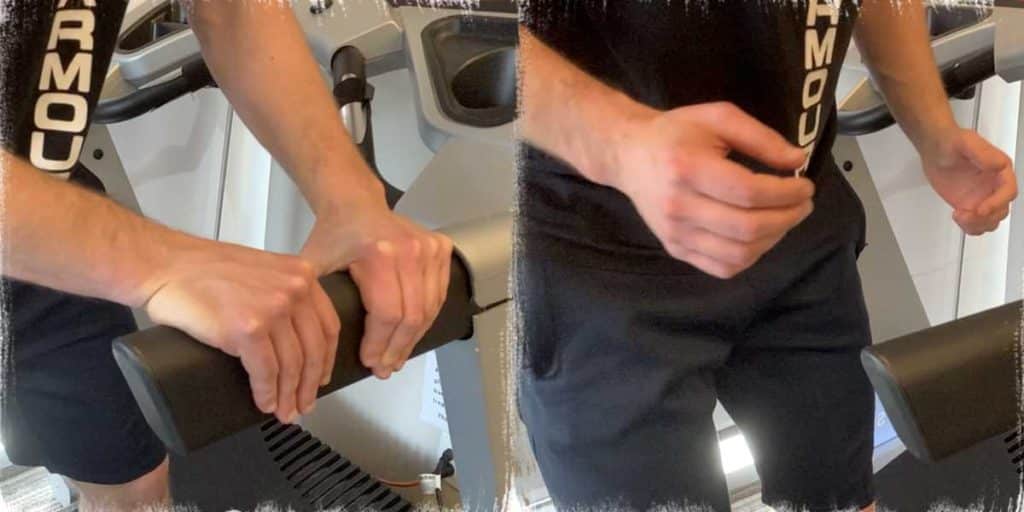
Benefit 3: Improved hip and leg strength
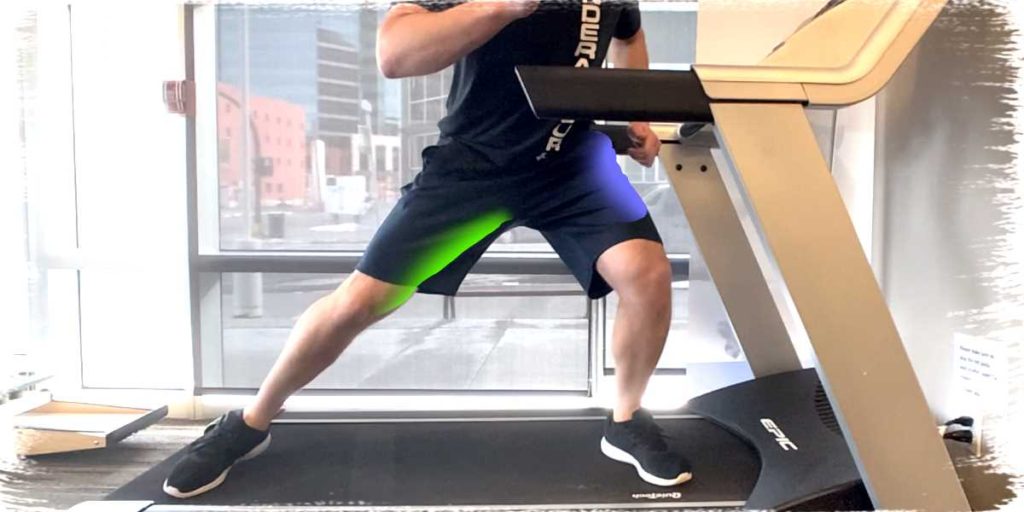
In addition to losing hip joint mobility and decreased mobility of the groin muscles (read benefit 1 in case you haven’t) when only training or exercising in the sagittal plane, we also lose strength of the muscles on the outside of the hip (abductor muscles) and on the inside of the leg (adductor muscles). These groups of muscles both work to produce sideways movements (such as side-stepping), which are movements that take place in the frontal plane of the body.
Weakness of the hip abductor muscles
Hip muscles that move the leg out to the side are known as abductor muscles. When we don’t perform sideways leg movements on a regular basis, these very muscles can become rather weak (and oftentimes dysfunctional) since they are never really called into play. Muscles must be challenged or stimulated on a regular basis in order to stay strong and healthy. When this fails to occur, they become weak and often lead to the inability to perform certain motions or activities. Even worse, they can also lead to pain or discomfort as well.
The primary hip abductor muscles are the gluteus medius and the gluteus minimus. There are other muscles that work in order to help to achieve this movement, but these two muscles in particular produce most of this movement. Unfortunately, these two gluteal muscles are absolutely notorious for being unhealthy and leading to all sorts of hip pain within a variety of individuals. Conditions such as gluteus medius tendinosis are no fun to go through, so do yourself a favour and don’t let them become weak in the first place.
Weakness of the groin (hip adductor) muscles
Another group of muscles that get weak when we only perform movements in a forward and backwards plane are the hip adductor muscles. These muscles are also known as the groin muscles (the group of muscles on the inner thigh). These muscles work to pull the leg back underneath our torso after the hip abductor muscles (the gluteus medius and minimus) have pulled the leg out to the side. But since we don’t often pull our legs out to the side, the groin muscles are never called upon to pull the leg back beneath our torso!
The result is a double whammy – without the hip-abduction muscles being used to pull the leg outwards from the body, there’s no major need for the adductor muscles to pull the leg back in towards the body, leading to muscular weakness for both muscle groups.
How sideways walking strengthens these muscle groups
Sideways walking on a treadmill challenges the hip abduction muscles and the groin muscles (also known as hip adduction muscles) much more directly and extensively than when compared to either forwards or backwards walking.
When facing sideways and then advancing forwards on a treadmill, the gluteus medius and minimus muscles of the lead leg must work to abduct the hip, which provides a rather direct stimulation or challenge for those muscles. As this happens, the trail leg moves out to the side but then must be brought back underneath the torso, the latter of which can only be done by contracting the groin or adductor muscles.
This means that for every sideways step that you take on the treadmill, the hip abductor muscles of the lead leg get stimulated while the adductor muscles of the trail leg also get stimulated. The result is an effective way to strengthen and maintain the overall health and wellbeing of your hips!
Pro tip: If your primary goal is to improve hip and leg strength, make sure that you spend half of your time with your right shoulder facing the front of the treadmill and the other half of the time with your left shoulder facing the front of the treadmill.
This is so that all of the hip abduction and hip adduction muscles are worked to an even extent. If you only face one direction the entire time, you’re largely only training the hip abductors (gluteus medius & minimus) on one hip and the groin muscles on the other thigh. By turning around and facing the opposite side half way through your session, you’ll train the opposite hip abduction muscles and hip adduction muscles on the other leg, respectively.
Benefit 4: Improved training variety
It’s often said that variety is the spice of life. And when it comes to spending time on the treadmill, having a little extra variety can go a long way. Many people fail to stick with their exercise or fitness routines simply because they feel that there is a lack of variety and thus get tired of doing “the same old thing” over and over again.
There are really no negative consequences to having more training variety available to you as you carry on with your fitness and health routine. If you already have a hip exercise routine that works on addressing the strength and mobility of your hips in different planes of movement, you now have one more way to do so.
If your goal is to simply “move” on the treadmill for a certain number of minutes, you can incorporate sideways walking into part of that movement session; you could walk facing forwards for a certain number of minutes, then switch to sideways walking for a duration of time, then switch back to walking forwards, or backwards, etc.
The point is that having extra variety as part of either your treadmill walking sessions or your overall hip strength & mobility routine(s) only serves to provide more variety in the long run, which helps to ensure that you not only stick with it, but that you therefore give yourself a better chance of maintaining good cardiovascular and hip health as you move on through life.
Benefit 5: It’s mentally engaging & requires concentration
Walking is absolutely great, so don’t get me wrong here. But my preference is to always do so outside. Forward-facing walking on a treadmill indoors can get incredibly mind-numbingly boring, especially if you don’t have anything in front of you (such as an iPad or TV screen) to distract you as you walk onwards.
This is largely due to the fact that walking is a relatively automatic task that we can perform. But walking sideways takes some concentration since it’s not as automatic of an activity for our brain and body to perform. So, in addition to all four of the previously mentioned benefits, you’ll also be afforded the benefit of having an activity that requires your mind to stay fixated on the task. This can actually be surprisingly enjoyable.
This mental engagement tends to make time fly by much faster on the treadmill, leading to more engaging and mentally stimulating sessions. As a result, it can take out (or at least greatly reduce) the dread of having to step on the treadmill and go through yet another “boring walk”. The end result can be greater enthusiasm and enjoyment than when compared to typical treadmill walking.
Bonus: Three different ways to walk sideways on a treadmill
There are four primary different ways to walk sideways on a treadmill, all of which have unique benefits and challenges. Whichever way(s) you choose to complete your sideways walking, make sure that you always feel that you’re in control and that the movement feels comfortable to perform. If you feel that you’re not in control, you’re compromising your safety.
Side-shuffling
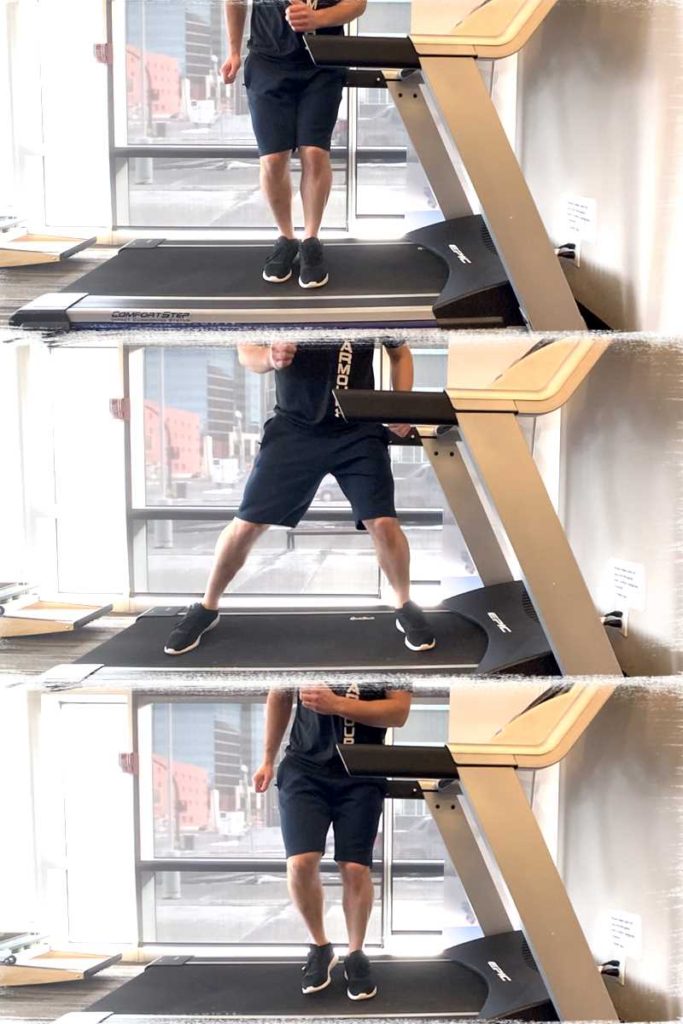
Side-shuffling is a form of sideways walking in which you bring the feet together in a side-by-side manner after having taken a step out to the side. The feet come side-to-side but never cross in front or behind one another. Side-shuffling is a great pattern to use for those who are looking for the least amount of challenge in regards to lower body coordination and range of motion required from the hip.
Side-shuffling therefore tends to afford higher levels of confidence when completing the movement due to its simplistic movement pattern, making it a great choice for those who want to feel safe and secure when walking/stepping sideways on the treadmill.
Front leg crossover
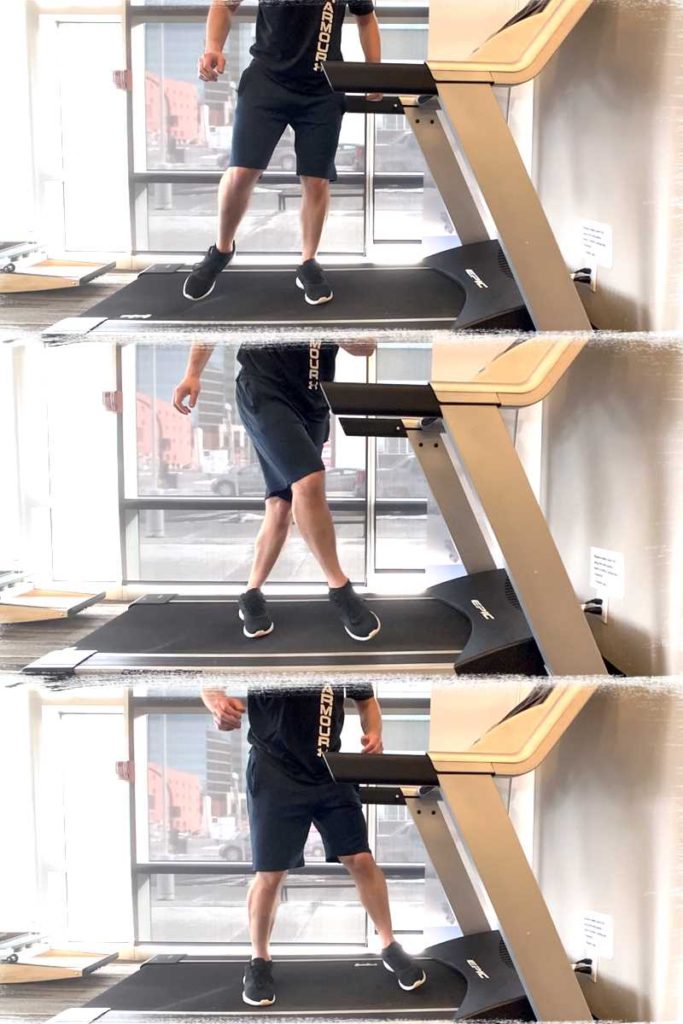
The front leg crossover pattern is perfect for those who want to experience larger ranges of motion from the hip (specifically through increased range of hip adduction) since the trailing leg is required to cross the midline of the body. It also tends to require more lower body coordination than the side-shuffling pattern.
As the name implies, the movement pattern involves crossing the trail leg in front of the stance leg each and every time when stepping.
Back leg crossover
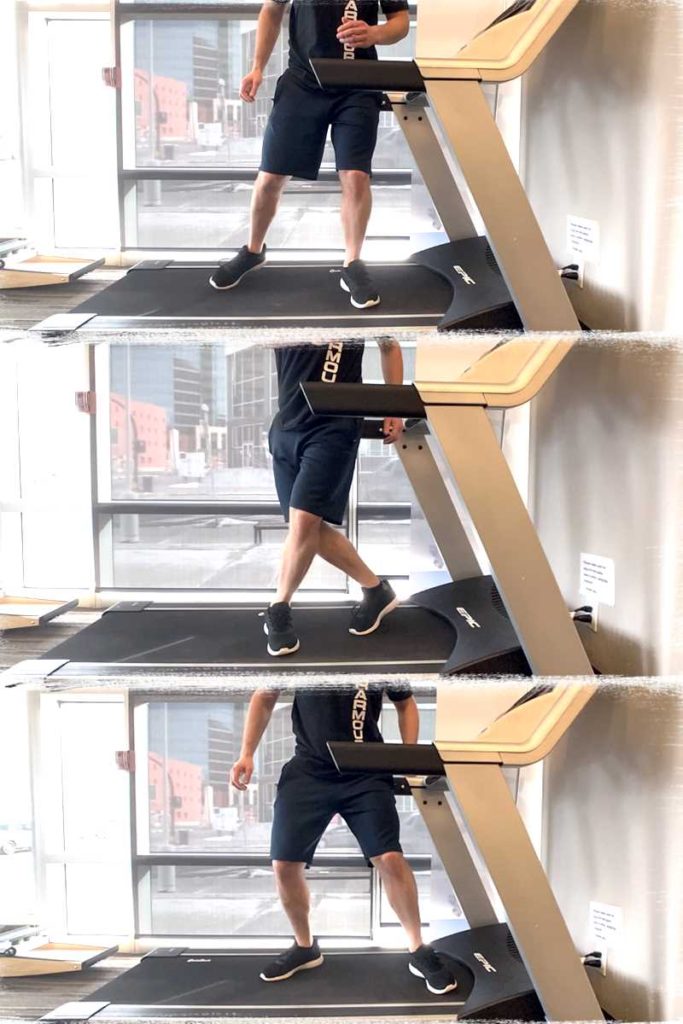
The back leg crossover is the sibling to the front leg crossover in that it affords the same challenges of the front leg crossover, but with the trail leg crossing behind the stance leg each and every time rather than out in front.
Alternating leg crossover
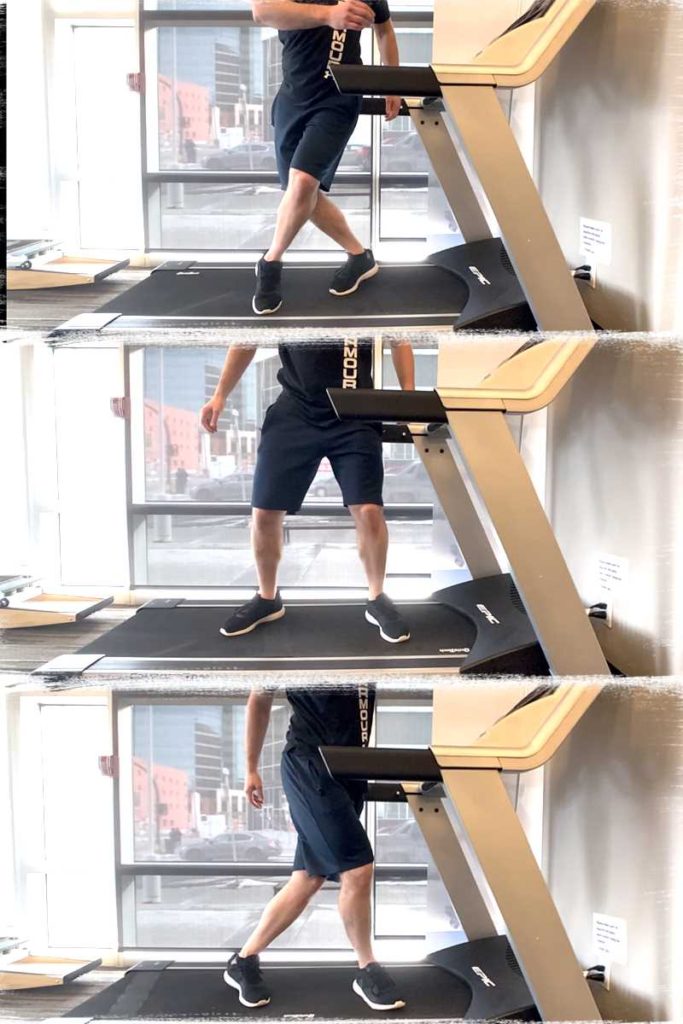
You’ve probably already figured out what this leg pattern consists of from its name alone, but just in case you haven’t:
The alternating leg cross over pattern is the utilization of the front leg and back leg crossover patterns, performed in an alternating fashion; the trail leg will cross in front of the stance leg for one repetition and then for the next repetition it will cross behind the stance leg. The process is then repeated for as long as desired.
This pattern tends to offer the greatest amount of lower body coordination, so make sure you feel confident and start with a slow belt speed when first giving the pattern a try. Hold onto the rail in front of you at first if need be. The last thing you want here is to trip over your own feet, lose your balance and fall down.
Final thoughts:
Not enough people incorporate sideways movements into their daily physical activities or exercise routines, with the unfortunate result oftentimes being hips that become tight, immobile, weak and even painful. In order to keep your hips healthier and your training more enjoyable, it could be a wise decision for you to incorporate some side-stepping or sideways walking into your exercise routine.
Don’t underestimate the physical challenges and subsequent benefits that can result from walking sideways on a treadmill as part of your fitness or exercise routine. Many people are either quick to dismiss it due to their lack of understanding with its benefits or simply because they’ve never thought to walk sideways on a treadmill at all.
Either way, don’t be one of those individuals who only exercises and moves in a forwards and backwards plane of movement. Start moving side to side and your hips and mind will thank you for doing so.

Hi! I’m Jim Wittstrom, PT, DPT, CSCS, Pn1.
I am a physical therapist who is passionate about all things pertaining to strength & conditioning, human movement, injury prevention and rehabilitation. I created StrengthResurgence.com in order to help others become stronger and healthier. I also love helping aspiring students and therapists fulfill their dreams of becoming successful in school and within their clinical PT practice. Thanks for checking out my site!


